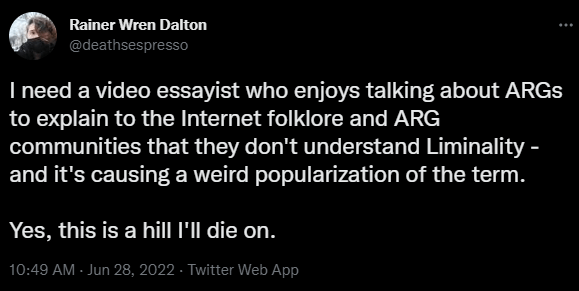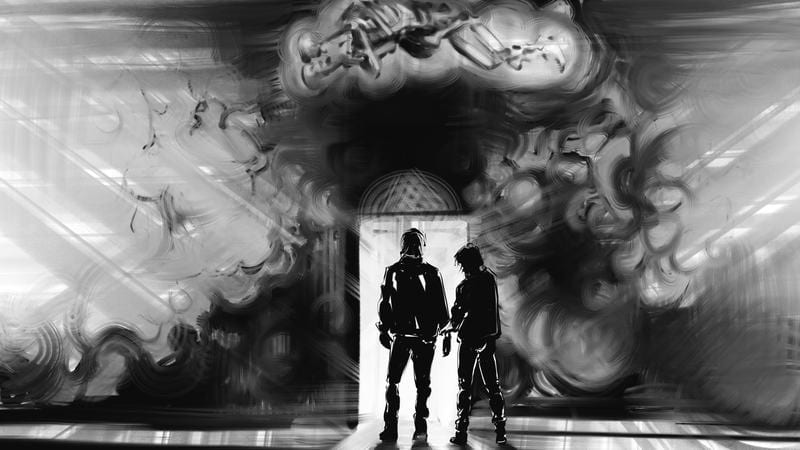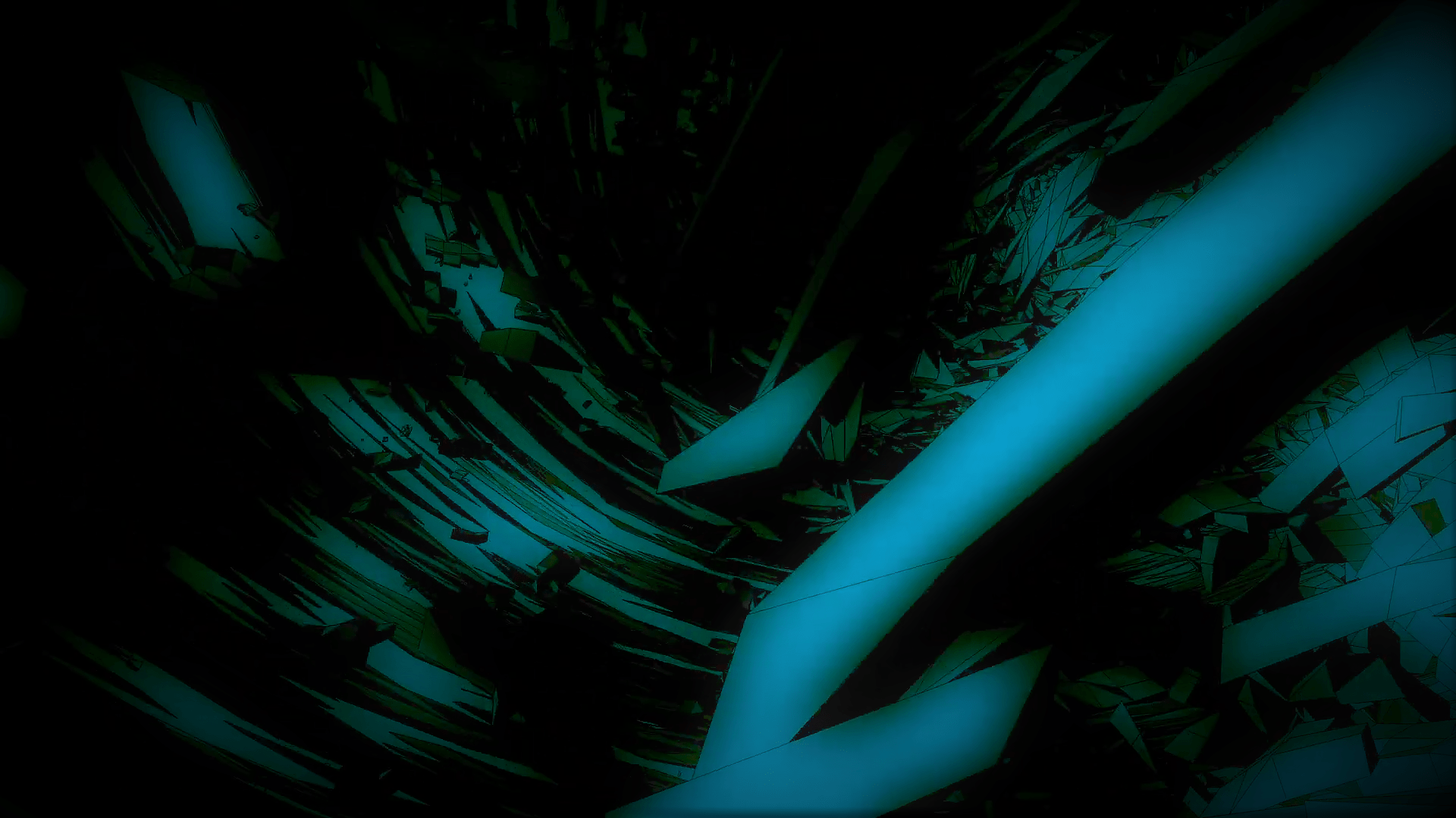“ She says, ‘People think it’s a fire but // mostly we just evaporate’
S. Preston Duncan
There’s this brilliant alternate reality game (ARG) on the scene that’s drawing on the traditions of e-literature [1] and narratively inclined Indie games [2] called Under the Surface (2021) that I want to introduce you to this month. Also, sue me [3], I’m going to talk about liminality. I know I said that I wouldn’t “make any moves to establish terms“, but that ship has pretty much sailed.

I respect that the ARG community has developed its own definition of liminality. Clearly, it’s a definition that speaks to a common experience with nostalgia laden architecture. What I want to point out is that I think the more precise anthropological definition opens even more possibilities for people to think about analog horror or ARGs or any other media. Relying on Victor Turner’s [4] definition of liminality opens up the possibility of directly addressing the conditions that might give rise to liminal spaces. Turner describes the liminal period of a coming-of-age rite in stating:
the characteristics of the ritual subject (the “passenger”) are ambiguous; he passes through a cultural realm that has few or none of the attributes of the past or coming state. (94)
Turner is specifically concerned with coming-of-age rites, but many scholars have broadened out the scope of what liminality can describe. In the case of something within our niche like Kane Pixel’s The Backrooms (2022), working through a few of said scholars might offer some insight as to how a vacant modern office building that doesn’t obey the laws of physics could qualify [5]. Today, however, we won’t be dealing with office buildings. Today, we deal with a coming storm.
Eveghost’s Under the Surface is not what I think most ARG community members would call ‘a game concerned with liminality. The story follows Axel Lundén, a solo-artist and former front man for the defunct Swedish band Nauru. Most of the narrative is embedded within the section labeled ‘read’ of Lundén’s webpage. All of the embedded story occurred in 2014 and cannot be altered by any player. This section of Under the Surface acts as a memoir[6]. Lundén writes his of experience in the wake of the suicide of his husband Micke Berg and addresses his related traumas including suicidal ideation. Eveghost does a masterful job of providing players and casual readers a space to meditate on a realistic depiction of what it means to be suicidal and depressed, while providing ample content warnings and opportunities for players to decompress. As a game, Under the Surface is situated in the present-day. The website is managed by Lundén’s bassist and bestie Kåre Jansson[7]. Jansson also manages the hidden web-elements, additional links, and puzzles. Jansson tasks players with recollecting and assembling mementos and ephemera that add to the meaning of said memoir. To that end, it’s worth pointing out that while Lundén is the de facto embedded narrator and game-wise protagonist, Jansson seems to have final editorial control on anything on the webpage.
To explain Under the Surface’s reliance on liminality, I want to start with a video originally presented in “Chapter 3: After the Storm”. The video is called “The Storm” and in the context of the chapter, it is a visualization of a dream Lundén is having. He must find Berg in his childhood home before a tornado kills them. The video is shot from Lundén’s perspective and therefore jumps around erratically. The color scheme is a nauseating blue green[8]. Eleven seconds into the video, sirens bellow and the constant ebb and flow of the overarching guitar track makes the piece feel monstrously uncertain. The house itself seems empty. It fulfills the sense of liminality described by Youtuber Nexpo, “that uncanny feeling of something derelict, that was once full of life, being left behind in the time-period you remember it from.” (00:09:22). It’s probably one of the only moments in Under the Surface that truly fulfills this definition of liminality. If we accept liminality as only being able to describe the “derelict” and “uncanny”, we miss so much texture of the trauma Lundén is processing. That’s not to say “The Storm” isn’t evocative of a liminal space; but it’s liminality is not necessarily best attributed to its emptiness.
In his article “Queering Queer Eye”[9], E. Tristan Booth defines liminality through Turner: “betwixt and between the positions assigned and arrayed by law, custom, convention, and ceremonial’’ (187). We can understand Booth as positioning liminality between certain social roles or realities. For those who decide to go to college, you might call the summer just before your freshman year liminal. At that time, you might be saying goodbye to friends, signing year books, or otherwise reimagining your hometown through the context of this transition period. Booth adds
liminality as a period of uncertainty, encourages a gaze toward the past. The liminal subject exists within a process of becoming other than what one has been… they may find themselves wondering whether or not the transformation has taken place at all. (189)
Booth’s idea of liminality isn’t empty – it’s full of ambiguity. It’s not knowing whether one has “come of age”, or in the case of the trans-masculine identity Booth is investigating, persistently existing between socially accepted constructions of gender. What I’m getting at is that the space between the start and end of a timeframe isn’t empty. It’s full of ambiguity, and navigating that mess is critical to our understanding of liminality. In the case of Under the Surface, this is often visualized by glitches or broken objects such as a shattered phone or a warped photo. Rosa Menkman’s “Glitch Studies Manifesto”[10] offers us a way to rethink how we read these glitches. Menkman argues that glitches can be constructed to have “positively generative”(5) qualities that force the reader away from contemporary ideas about how seamless media should be. Menkmen sees the glitch as a tool to show that holistic imperfect depictions of technology can be places where we can see materials as more than broken (7). The glitch is more than an interruption – it’s something that contains meaning on its own, even if that meaning is ambiguous. If you combine Menkmen and Booth, then you can see why glitches and liminality work so well together. Both present a meaningful but ambiguous space between things, something that isn’t derelict but is deeply imperfect.

So now, what do we make of Under the Surface? Let’s look at a moment at the end of “Chapter 9: The Tomb”. Kåre and Lundén are leaving the Emanuel Vigeland Mausoleum and processing their experiences the night before. Kåre tells Lundén that Berg’s death wasn’t his fault; Lundén thinks to himself that he “…drove him [Berg] to it”. There’s an illustration at the end of the chapter that’s just haunting; the door of a mausoleum with two skeletons deep in embrace. This is a contender for the most liminal thing in the whole damn story. Lundén exists perpetually between the states of being a husband to Berg and being a widower. He can’t seem to move on in any sense of the term. The illustration’s two skeletons seem to evoke Lundén and Berg in death. The silhouette of Kåre and Lundén evokes the inverse: who Lundén is in life. The door is somehow between both. Clicking through the embedded link within the illustration will bring you to a page showing images of the real tomb, accented with the glitching of the word “transform”. Transform indeed.
All this to say, Under the Surface is liminal not because it is empty. It’s liminal because Lundén is experiencing the full force of being between culturally anticipated spaces within his life [11]. And that’s not even considering that he’s grieving a marriage that resists even being described through hegemonic social norms [12]. I hope that’s helpful. I hope seeing liminal things as full and ambiguous helps you find more meaning in the art you’re consuming.
As for Under the Surface, it’s unambiguously worth your time. I could keep writing about this ARG for hundreds of pages and I wouldn’t fully capture the depth of the character writing alone[13]. I could not recommend something more fully [14]. If you’re interested in getting involved in the ARG, I highly recommend you check out Eveghost’s own “Players guide” which will get you started on all of the basics I didn’t cover. Additionally, the player-base is currently located in the hub discord-server Vehemence. Feel free to jump in; it’s a welcoming community and they’ll be happy to get new players situated. The next chapter of Under the Surface is coming out today and as soon as Chapter 11 is available, it’ll be linked here! Thank you all for your continued readership, I’ll see you next month.
Special thanks to Ash Black, Alex Hera, Eveghost, Gem, and John Rudy, for their edits on this review. I deeply appreciate their assistance in ensuring that this is accessible, well written, and grammatically sound.
Endnotes:
[1] Similar to Anna Anthropy’s Queers in Love at the End of the World if you’re familiar. ↵
[2] Similar to Nomada Studio and Conrad Roset’s Gris if you’re familiar. ↵
[3] Please, don’t sue me. I am but a broke PhD student. ↵
[4] Turner is widely credited for the term liminality due to his book The Ritual Process: Structure and Anti-Structure (1969) where he examines the rituals of the Ndembu in Zambia, but Turner is really building on the work of Arnold Van Gennep in The Rites of Passage (1909). ↵
[5] If I really wanted to do Kane Pixels justice, I’d probably use Marc Auge’s Non-places: Introduction to Anthropology of Supermodernity (1992). If you want a quick digest of non-places, here’s the Wikipedia article. ↵
[6] Lundén’s last solo album was also called “Under the Surface” and also acts as a memoir for his experience grieving Berg. One of the editors for this piece, Gem, suggested some time be given to breaking down the meta nature of this layering. I think that’s a fantastic idea; so if you’re looking for a video essay idea… ↵
[7] Affectionately called “Nerd Jerk” by players. His memes are top tier. ↵
[8] It’s very similar to Italian Giallo horror cinema in that regard – with its strong color contrasts and moody atmosphere. ↵
[9] Booth’s Specifically taking a crack at reading the episode “Trans-form This Trans-man” season 4, episode 9 of Queer Eye for the Straight Guy (2003). It’s a fantastic piece and in an alternate draft of this review it inspired me to spend way more time talking about queerness and Eveghost’s work. ↵
[10] Menkman’s blog is about as wild as her manifesto. I respect the hell out of someone who enacts their process within their entire body of work. I highly suggest you look at Beyond Resolution. ↵
[11] In the process of writing this review I asked Eveghost about the epigraph. We joked around about making it “People always ask ‘who the hell is Axel Lundén’ but they never ask ‘why the hell is Axel Lundén'” and attributing it to “definitely not Axel Lundén”. ↵
[12] Here hegemonic just refers to ideas that are dominant within a culture and maintained as part of that culture. We can go into detail on the word in another review if you want, reader. Leave a comment if you want me to break down hegemony and counter-hegemony some time! ↵
[13] Eveghost is also an anthropologist, and has said this on the subject of liminality “I think an important point about liminality as it is in anthropological explorations of ritual, is that it’s a scary place to be, deeply uncomfortable and people going through the ritual can feel like they’re going to die. In many cultures it is a ritual death. But once one stands on the cusp of moving on, there’s a feeling of anticipation and even hope. After the ritual, there’s a sense of pride in moving forward and a new status to contend with.” ↵
[14] I should at some point disclose that I am a transmedia consultant on Under the Surface. However, that role is extremely small and had no bearing on the specific points I raised in this review. ↵
Works Cited:
Booth, E. Tristan. “Queering Queer Eye: The Stablity of Gay Identity Confronts the Liminality of Trans Embodiment.” Western Journal of Communication, vol. 75, No. 2, 2011, https://doi.org/10.1080/10570314.2011.553876 . Accessed 10 July 2022.
Duncan, S. Preston. The Sound in This Time of Being. Richmond, BIG WRK, 2020.
Eveghost. “Chapter Three: After the Storm ” Under the Surface, https://www.axel-lunden.com/uts-story-pages/under-the-surface-chapter-three . Accessed 10 July 2022.
Eveghost. “Chapter Nine: The Tomb ” Under the Surface, https://www.axel-lunden.com/uts-story-pages/under-the-surface-chapter-nine . Accessed 10 July 2022.
Eveghost. “The Storm” YouTube, uploaded by Axel Lundén Archive. 24 Oct. 2021, https://youtu.be/GxG_ZxpVDcQ.
Menkman, Rosa. “Glitch Studies Manifesto.” 2010, http://rosa-menkman.blogspot.com . Accessed 10 July 2022.
Ryan. “The Darkest Half-life Mod” YouTube, uploaded by Nexpo: After Hours , 24 June 2022, https://youtu.be/yWO4zrYgrvc .
Turner, Victor. “Liminality and Communitas”. The Ritual Process: Structure and Anti-Structure. Ithaca, Cornell University Press, 1977.
